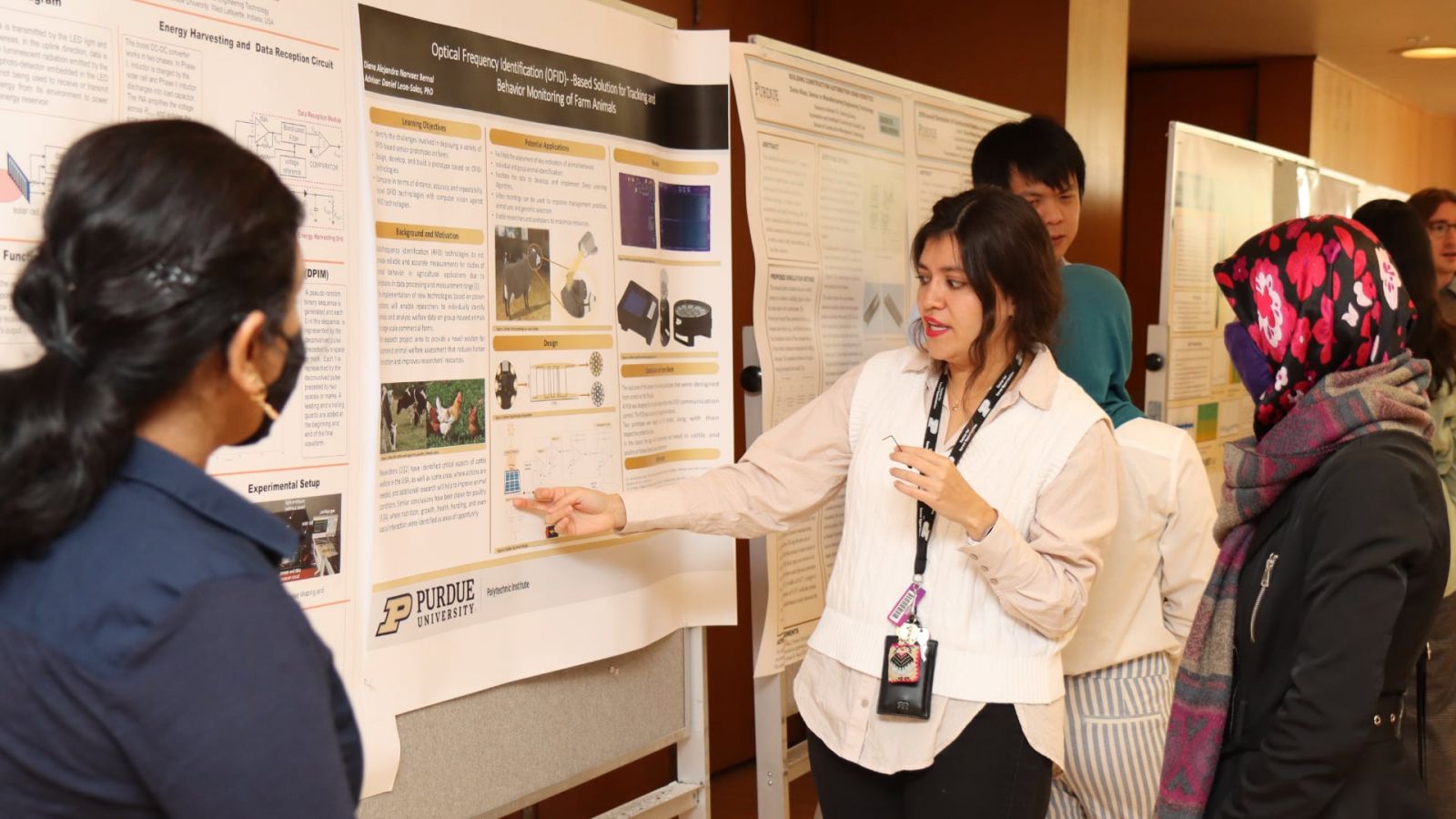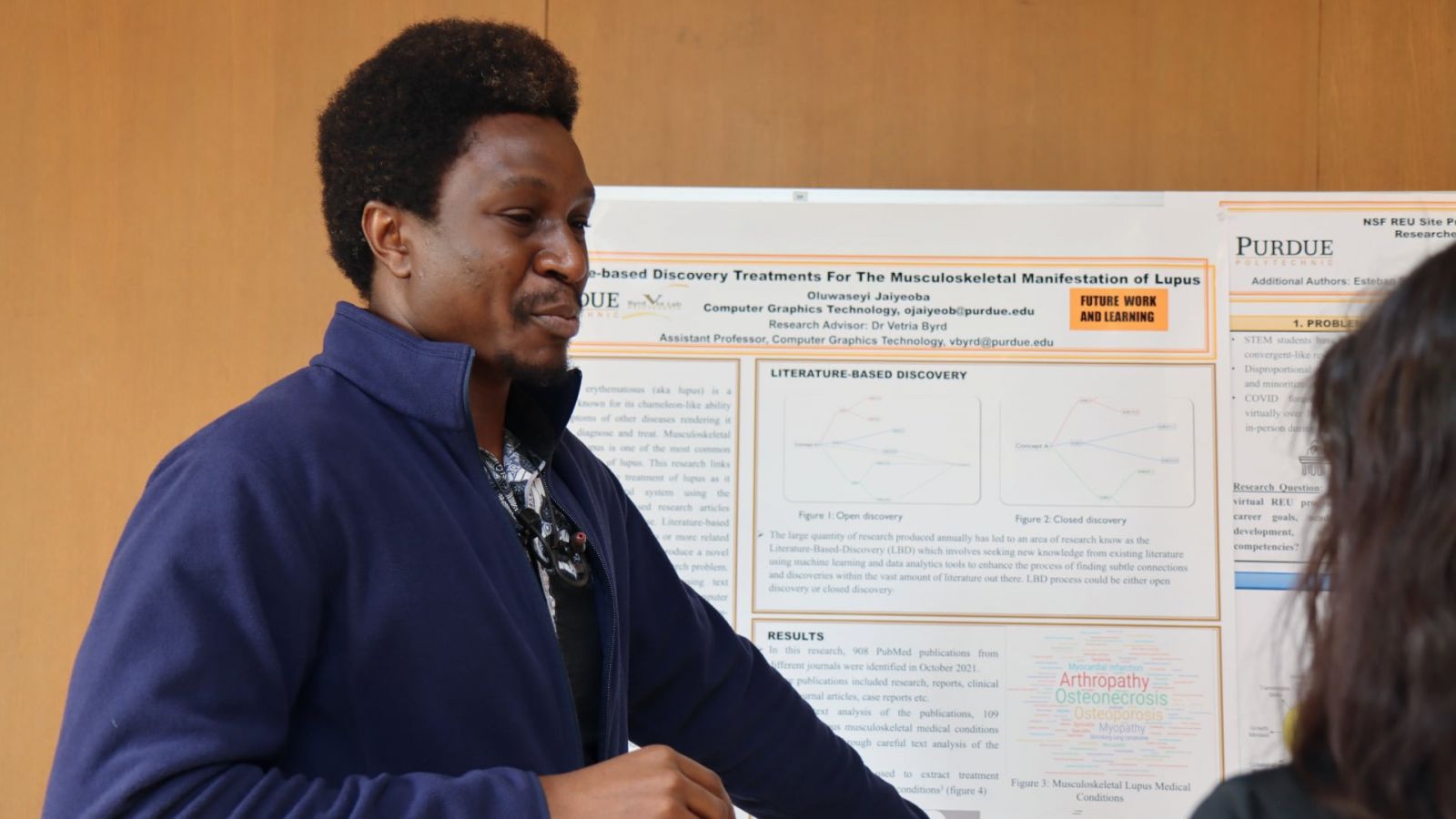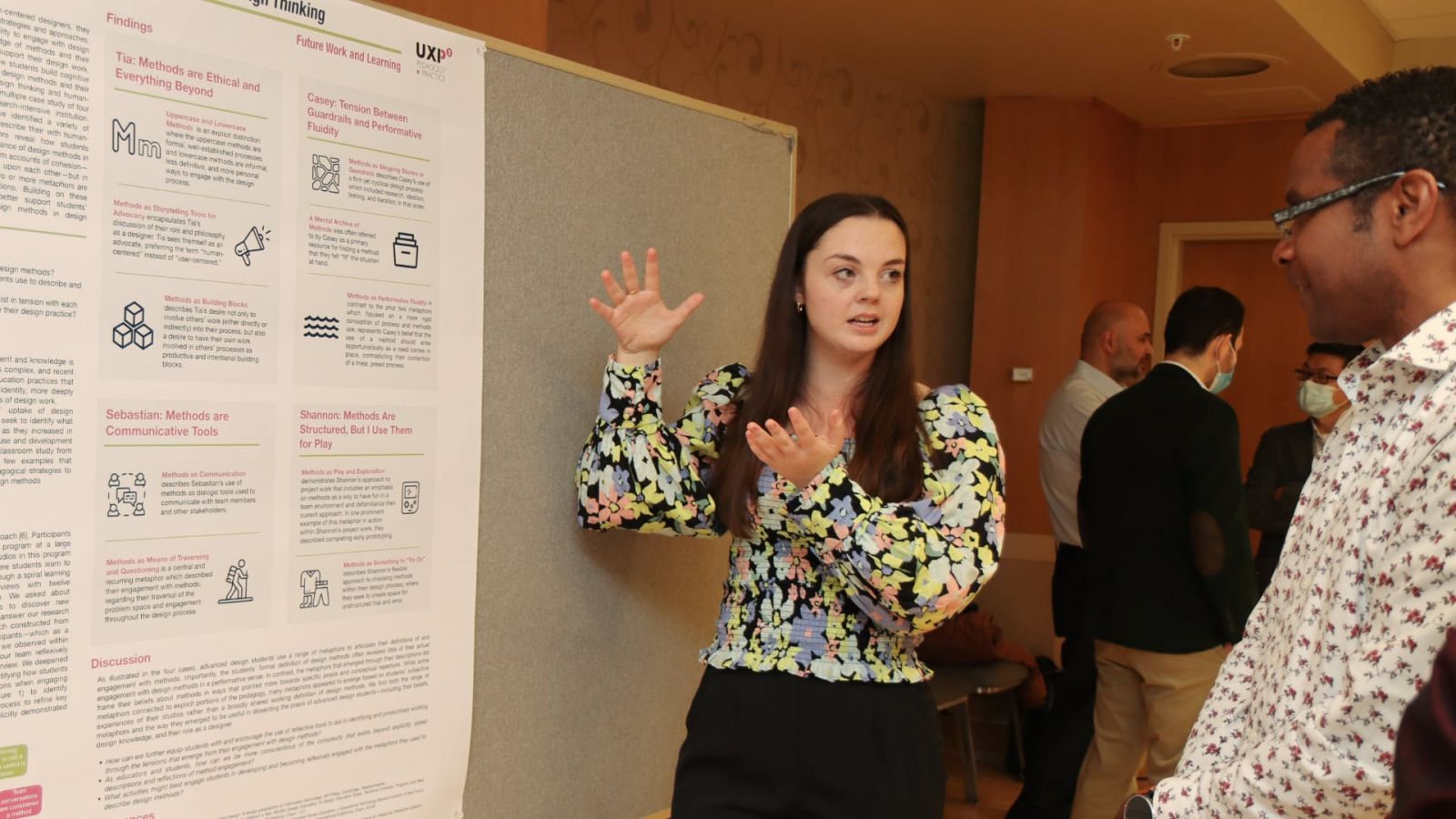
Undergraduate and graduate students in Purdue University’s Polytechnic Institute presented posters summarizing their 2021-2022 research projects at Stewart Center last Tuesday (April 26, 2022).
Students engaged in research affiliated with each of the Polytechnic’s strategic research impact areas (RIA), including Future Work and Learning, Holistic Safety and Security, and Realizing the Digital Enterprise. Titles and research abstracts for the Future Work and Learning-affiliated projects are listed here.
“It was great to see and show to others the wide range of research conducted in the college and recognize the amazing work graduate and undergraduate students are conducting,” said Luciana Debs, assistant professor of construction management technology and co-leader of the Future Work and Learning research impact area. “Students were extremely engaged with sharing their research with faculty and fellow students.”
Future Work and Learning
Xingzhou Guo, “Life Cycle Integration of Building Information Modeling in Infrastructure Projects”
Abstract: The Indiana Department of Transportation (INDOT), as an owner and facility manager whose responsibility is to build and maintain transportation infrastructure, must collect accurate and complete asset data throughout the life cycle of each project to effectively operate and maintain infrastructure assets in Indiana. Accurate and complete information is the key for effective asset operation andmaintenance (O&M).
However, current information management at many state Departments of Transportation (DOTs), including INDOT, faces inefficiencies because information required for O&M can be inaccurate, incomplete, being hard to locate, or even non-existent. It is not uncommon for the O&M staffs and engineers to have to (1) locate information after the fact in different file formats and different systems, (2) verify information accuracy by accessing the current conditions with different stakeholders, and (3) manually re-create, re-collect, and re-input information to O&M systems based on new site investigations. Some information might be invisible or physically inaccessible after the fact. This whole process is error-prone, time-consuming, filled with repeated work, and can even be dangerous. Building Information Modeling (BIM) has been advocated as a potential solution to many issues of asset management.
Joseph Fraseur, “Solar Photovoltaics and Off-Grid Applications”
Abstract: Camper vans are experiencing a resurgence in popularity. Some users desire to power these mobile dwellings using photovoltaic (PV) systems. The installation of a PV system allows the creation of a micro grid for the vehicle. Independent of the grid, the PV system consists of solar panels, inverters, and other means of power generation, conditioning, and use.
Over time these systems and individual components have become more efficient and affordable. The increased accessibility of these systems has impacted the consumer and the available choices for travel and day to day living. This document is developed with the intent of bringing existing research to the forefront and providing supporting documentation for future research in this area. This work specifically focuses on the three prevailing types of solar panels and their modes of power generation.
Aparajita Jaiswal, “Characterizing the psychosocial effects of participating in a year-long residential research-oriented learning community”
Abstract: Research on learning communities has primarily focused on identifying institutional outcomes such as student achievement and retention. However, more research is needed on how the learning community experience impacts the motivation, beliefs, and perceptions associated with student success. This study investigates the psychosocial effects of participating in a residential research-oriented learning community regarding students’ interest and motivation in pursuing research-oriented careers, research and data self-efficacy beliefs, sense of belongingness with the learning community, and socialization levels, and career awareness in research-oriented fields.
This study also investigated the mediating effects of students’ initial research self-efficacy beliefs on differential gains regarding career awareness, motivation and interest, and sense of belongingness and socialization after one year of participating in a residential research-oriented learning community. Participants of the study consisted of five cohorts of the learning community, each composed of twenty students. Students in each cohort participated in a pretest-posttest design survey study. Findings suggest that alignment of student interest with the learning community discipline is a key mediator of student growth in their self-efficacy beliefs, sense of belongingness with the learning community and levels of socialization, and career awareness in the selected field.

Oluwaseyi Jaiyeoba, “Literature-based Discovery Treatments for The Musculoskeletal Manifestation of Lupus”
Abstract: Systemic lupus erythematosus (aka lupus) is a chronic disease known for its chameleon-like ability to mimic symptoms of other diseases rendering it hard to detect, diagnose and treat. Musculoskeletal manifestation of lupus is one of the most common clinical manifestations of lupus. This research links disparate literature on the treatment of lupus as it affects the musculoskeletal system using the discoveries from literature-based research articles available on the PubMed database.
Literature-based discovery methods can connect two or more related but disjointed literature concepts to produce a novel and plausible approach to solving a research problem. Data visualization techniques with the help of Natural Language Processing (NLP) tools are used to represent the literature-based discoveries visually. Literature search results can be voluminous, but data visualization processes can give insight and detect patterns in large data. These insights and patterns can lead to discoveries that would have otherwise been hidden from disjointed literature.
This research methodology involves using text mining, natural language processing, and computer graphics techniques to identify patterns in lupus-related data that, when visually represented, could aid research in the treatment of lupus. In this work, we introduce a method for visually representing interconnections of various lupus-related literature
Bhavana Kotla, “Growing Entrepreneurially Minded Undergraduate Researchers with New Product Development in Applied Energy”
Abstract: Undergraduate research programs benefit students, faculty, and universities. Due to the benefits of undergraduate research, the National Science Foundation (NSF) has funded Research Experiences for Undergraduates (REU) in science, engineering, or mathematics programs, allowing students to participate in research programs at universities across the United States during the summer.
In industry, new product development, marketing research, and project management tend to work differently than in academia. CEOs, project managers, and design leads are less concerned with how new theories or data analysis techniques can be applied and where good ideas come from and instead are more concerned with their effective implementation. The problem is that STEM students have limited exposure to the convergent-like research that is often required of employees working in the industry. Given the ever-present disproportional participation of women and minority populations in STEM, this problem only exacerbates and further excludes broader participation from a diverse audience of students. This poster will showcase the findings from a virtual REU program that provides students with a research experience that combines the best aspects of academic applied research (including theoretical basis and rigorous scholarship) with essential business practices (including real-world customer discovery and the generation of sound business models).

Anne Pivonka, “Metaphors that Shape Students' Engagement with Design Thinking”
Abstract: As students develop competence as human-centered designers, they must learn a wide range of design thinking strategies and approaches. One type of design competence is one’s ability to engage with design methods, encapsulating both one’s knowledge of methods and their ability to performatively utilize methods to support their design work. Currently, little research exists to describe how students build cognitive schema in relation to the use and uptake of design methods and their developing mindset when engaging with design thinking and human-centered design.
In this poster, we present a multiple case study of four advanced design students at a large research-intensive institution. Through analysis of in-depth interviews, we identified a variety of organizing metaphors that students use to describe their with human-centered design methods. These metaphors reveal how students describe, engage in, and evaluate the performance of design methods in their design work. Metaphors we identified form accounts of cohesion—where two or more metaphors align or build upon each other. But in some cases also surface tensions—where two or more metaphors are misaligned or otherwise present contradictions. Building on these metaphors, we identify opportunities to better support students’ development of mindsets to activate design methods in design education.
Chi Tian, “Implementation Exploration of Autonomous Vehicles: Impacts of Autonomous Truck-Mounted Attenuator (ATMA) on INDOT Work Zone Safety, Mobility, and Crews’ Perception/Behavior/Productivity”
Abstract: From 2015 to 2019, an average of 5,470 collisions happened every year in Indiana work zones. Specifically, there were 14 deaths and 650 injuries in 2018, and 25 deaths and 805 injuries in 2019.
The study aims to reduce the number of injuries and deaths of INDOT crews by changing the truck mounted attenuator (TMA) into autonomous truck-mounted attenuator (ATMA).
Lucas Wiese, “A Computational Cognitive Apprenticeship to Promote IoT and AI Learning for Workforce Development in Smart Manufacturing”
Abstract: Emerging technologies surrounding the Internet of Things (IoT) and Artificial Intelligence (AI) bring promise to revolutionize the manufacturing industry. However, small and medium manufacturers struggle to find employees capable of rising to the demands of data-intensive challenges in industry. This project explores effectiveness of a Computational Cognitive Apprenticeship for solving manufacturing related problems using machine learning (ML). The learning innovation was deployed as a pre-laboratory assignment and gauged students’ perceptions and intuitions of ML skills. With qualitative data analysis, we identified that the learning innovation supported students’ learning experience. The findings suggest that further research on ML pedagogy for manufacturing-relevant problems can support the skill gap.
Hongyue Wu, “Cognitive Attention and Its Application in Countermeasures on a Curve Section”
Abstract: The project aims to propose a methodology to evaluate the effectiveness of countermeasures of traffic safety based on drivers’ cognitive attention and driving performance. An experiment combining eye tracker and driving simulator was applied. With the data of 60 participants, the results of Analysis of Variance (ANOVA), visualization of attention, and machine learning showed the effectiveness of different countermeasures and impacts of weather and traffic flow.
Additional information
- Student researchers present Realizing the Digital Enterprise projects at spring poster session (1 of 2)
- Student researchers present Realizing the Digital Enterprise projects at spring poster session (2 of 2)
- Student researchers present Holistic Safety and Security projects at spring poster session
- Purdue Polytechnic’s Strategic Research Impact Areas
- Purdue Polytechnic Office of Research
- Purdue Polytechnic’s Holistic Safety and Security research projects receive national attention, funding
- Future Work and Learning research projects focus on all human-technology interactions
- Realizing the Digital Enterprise researchers pair technology, social responsibility
- Undergraduate researchers present projects at fall expo
